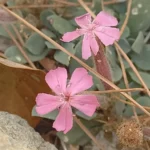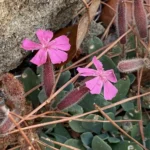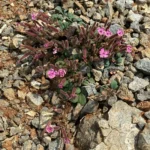Σαπωνάρια η κύπρια, Σαπουνόχορτο
Etymology for Saponaria Cypria
The genus name, Saponaria, is derived from the Latin word "sapo," meaning "soap." This refers to the fact that the roots of many plants in this genus contain saponins, which are compounds that produce a soapy lather when mixed with water. The species name, cypria, is the feminine Latin form of "Cypriot," and it indicates that this particular plant is native and endemic to the island of Cyprus. Therefore, the name Saponaria cypria literally translates to "Cypriot soapwort."
General Characteristics and Classification of Saponaria Cypria
Saponaria cypria is a species of flowering plant belonging to the family Caryophyllaceae, commonly known as the pink or carnation family. Within this family, it is classified under the genus Saponaria, which is often referred to as soapworts. The name Saponaria comes from the Latin word "sapo," meaning "soap," because the roots of many plants in this genus contain saponins, a compound that creates a soapy lather when mixed with water. Saponaria cypria is a perennial plant, meaning it lives for more than two years, and is an autotroph, producing its own food through photosynthesis.
Morphology of Saponaria Cypria
This plant is an erect or spreading perennial that typically grows to a height of 10–30 cm. It has a thick, branched woody rootstock.
The leaves are loosely clustered at the base, and they are either glabrous (hairless) or have thin cilia (small hairs) at the base of the petiole. The leaves are spatulate, obovate, or oblanceolate in shape and measure about 2.5–5 cm long and 0.5–1.5 cm wide.
The flowers are actinomorphic (radially symmetrical), with five deeply emarginated petals, and they are usually pink. They can be solitary or arranged in cymes. The plant is known for its long, red, glandular calyxes, which remain ornamental even after the flowers fade. The flowers are described as opening in the evening and closing around noon of the following day.
Saponaria cypria is a hemicryptophyte, a type of perennial plant where the dormant buds are located at or just below the soil surface.
Habitat and Distribution
Saponaria cypria is an endemic species of Cyprus, meaning it is found nowhere else in the world. Its distribution is confined to the Troodos Forest, including areas such as the Troodos Square, Chionistra area, Prodromos village, Trooditissa monastery area, and Xerokolymbos area. It thrives in high-altitude habitats, specifically between 1375 and 1950 meters above sea level. This plant is typically found in rocky areas, forest openings, screes (slopes of loose rock fragments), and along the banks of streams. Its flowering period is between July and September.
A Nocturnal Bloom with a Unique Look
One of the most exciting and distinctive features of Saponaria cypria is the behavior of its flowers. While many flowers open during the day to attract pollinators like bees and butterflies, the flowers of this plant are known to open in the evening and close around noon the following day. This suggests a specialization for nocturnal pollinators, such as moths, which are active after dusk.
Beyond their unique schedule, the flowers themselves have a striking appearance. While the petals are a beautiful, rich pink, a notable characteristic is the long, red, and glandular calyx (the leafy part that encloses the base of the flower). These calyxes are so prominent that they remain highly ornamental even after the flowers have faded, creating a lasting visual interest. This feature is particularly appreciated by rock garden enthusiasts and botanists.
A Natural Soap with Special Properties
The genus name Saponaria hints at a fascinating chemical property, and Saponaria cypria is no exception. Its roots contain a high concentration of saponins, which are compounds that produce a soapy foam when mixed with water. This characteristic has led to local research into its potential as a natural, non-toxic soap. The Frederick Research Center in Cyprus has been working on a project to develop a natural soap from Saponaria cypria extracts.
Interestingly, this research has also revealed that Saponaria cypria has stronger antioxidant and antimicrobial properties than the more common Saponaria officinalis. This enhanced bioactivity is believed to be a result of the unique microclimate of Cyprus where the plant grows. The potential for a natural, antibacterial, and gentle soap from this endemic plant is an exciting area of study with possible applications in cosmetics and medicine.







